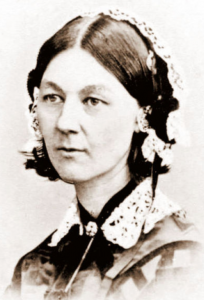This piece was written in celebration of Women’s History Month My interest in Ms. Nightingale was reignited a few weeks ago when I was prepping to train a group of military medical staffers. My topic was “An Intro to Lean Six Sigma,” a discipline that applies statistical tools and fact-based analysis to solve complex business problems. As I reviewed the slides for my presentation, one in particular caught my attention. This slide showed the historical timeline of Lean Six Sigma, with photos and names of its major contributors. Suddenly, it struck me that there wasn’t one woman on the page! So I did a little research, and I quickly realized that I had to add Florence Nightingale to the timeline, right after W. Edwards Deming, one of the “fathers” of Total Quality Management. But why, you ask, would I include the founder of modern nursing on a timeline about the evolution of Lean Six Sigma? Like most people, you probably remember Florence Nightingale as a nurse who treated wounded soldiers. What you probably don’t know is that she was also an outstanding statistician. It all began when Florence was serving at a British Army hospital during the Crimean War (1853-1856). As she cared for her patients, she noticed that more men were dying from infections like cholera and typhoid than from war wounds. Since medical records were often sparse and inaccurate, she started to record detailed data about the various causes of soldier deaths. She then went a step further, researching and carefully documenting contributing factors — things like poor sanitation, limited physical activity, and lack of proper nutrition. This was the beginning of Florence’s use of Lean Six Sigma methods, even though the term wouldn’t be coined until 100 years later! When she analyzed her findings, Florence concluded with dismay that, “our soldiers are enlisted to die in barracks.” Convinced that healthcare reform was necessary, she promptly set about implementing improved procedures at the Army hospital, which led to a 40% decrease in deaths from secondary infection. After leaving Crimea, she wrote a book based on her findings — one of the earliest documented uses of statistics to assess public health and welfare. She also created a visual statistical model to represent her data; this model became known as the Nightingale Rose Diagram, or Coxcomb, and was one of the earliest uses of data visualization for the purposes of urging reform. This was pretty amazing for a woman in the 1850s: instead of relying on her wealthy family’s name, she was solving life-and-death problems! A photo of her original model is shown below, and a fun interactive version can be found here. Florence went on to assist with sweeping healthcare reform, both in the British Army and beyond. She opened the first modern school of nursing, making sure nurses were trained in fact-based decision-making — a foundation of today’s Evidence Based Practice. Because of her great impact and dedication, Florence was named the first female fellow of the Statistical Society of London (now the Royal Statistical Society). Through all of her work, Florence proved herself to be a visionary, a pioneering critical thinker, and a skilled statistician. This is why, in all of my future training sessions, I’ll make sure to give her the credit she deserves and include Florence Nightingale as a contributor to Lean Six Sigma! __________________________________________________________ In honor of Women’s History Month, I’d like to re-introduce you to a woman you probably think you know a lot about already: Florence Nightingale. Yes, that Florence Nightingale. She is, of course, the iconic symbol of the modern nurse, but she accomplished so much more than what we read about in our history books.
In honor of Women’s History Month, I’d like to re-introduce you to a woman you probably think you know a lot about already: Florence Nightingale. Yes, that Florence Nightingale. She is, of course, the iconic symbol of the modern nurse, but she accomplished so much more than what we read about in our history books. Marliese Bartz is a certified Lean Six Sigma Black and the creator of StickyNote Strategy™. She helps businesses improve efficiency and customer satisfaction in a methodical, easy-to-understand way. She also trains new Lean Six Sigma practitioners and helps owners make strategic business decisions. She can be contacted through LinkedIn.
Marliese Bartz is a certified Lean Six Sigma Black and the creator of StickyNote Strategy™. She helps businesses improve efficiency and customer satisfaction in a methodical, easy-to-understand way. She also trains new Lean Six Sigma practitioners and helps owners make strategic business decisions. She can be contacted through LinkedIn.
[March 2015], an observation which pays tribute to generations of women whose commitment to bettering society has made immeasurable impacts.






